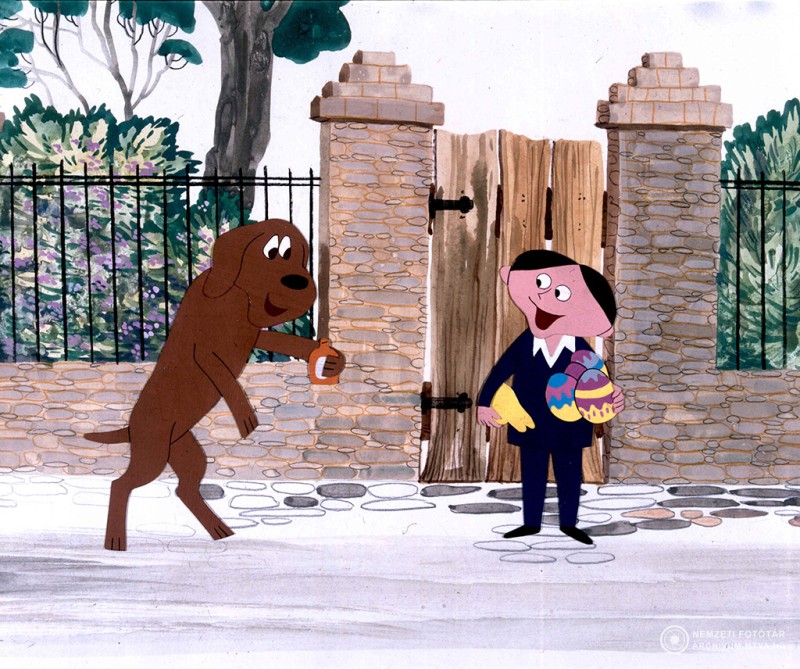A „pákosztos” macskák rémének ötlete Bálint Ágnes valós élményein alapult, aki maga is nagy kutyabarát volt. A legendás meseíró és tévés személyiség egyik legnépszerűbb sorozatáról számos érdekességet gyűjtöttünk össze önöknek.
1971. decemberében a sajtó hírt adott egy új, eredetileg 13 részes rajzfilmsorozat Pannónia Filmstúdióban zajló munkálatairól. A Magyar Televízió megbízásából készített műsor szereplőit az ismert karikaturista, Várnai György tervezte, aki így vallott a projektről: „Már csak azért is örömmel vállaltam el a Frakksorozat szereplőinek megformálását, mert szeretem az állatokat. Többszörös kutyatulajdonos vagyok, akárcsak forgatókönyv-író partnerem: Bálint Ágnes.”
The idea of the cat menace was based on the real experiences of Ágnes Bálint, who was a big dog lover herself. We've collected a number of interesting facts about one of the most popular series of the legendary storyteller and TV personality.
In December 1971, the press reported on the work in progress at the Pannonia Film Studio on a new series of cartoons, originally in 13 parts. The characters in the programme, commissioned by Hungarian Television, were designed by the well-known cartoonist György Várnai, who gave this testimony about the project: "I was delighted to take on the task of drawing the characters of the Frakk series simply because I love animals. I have several dogs, as does my screenwriting partner Ágnes Bálint."
A televízió a megrendelés idején nem határozta meg, hogy milyen technikával készüljön a rajzfilm, így „a rajz- és bábfilm újszerű kombinációját” alkalmazták. „Minden egyes szereplőnek megrajzoltuk és kartonpapírból kivágtuk a fejét és alakját, egyenként 80—100 változatban. Csak elő kell venni a dobozokból — mondjuk — Frakk alvó, ébredő, nevető, mérges, dühös, sunyi tekintetű, lógó nyelvű fejét, és kikeresni hozzá az ülő, álló, fekvő, ugró, szaladó testet. Ezeket ráillesztjük az előre megrajzolt háttérre és — minden mozdulatot külön beállítva — lefényképezzük. Ezekből a képekből — mintegy 8—10 ezer felvételből — áll össze egy-egy 6 perces történet.” – mesélte Cseh András, a rendezők egyike, aki e technika hazai mestere volt.
At the time of the commission, the television company did not specify the technique to be used for the cartoon, so they used "a novel combination of animation and puppetry". "We drew the head and figure of each character and cut them out of cardboard, 80 to 100 versions of each. You just have to take out of the boxes, say, the sleeping, waking, laughing, angry, angry, sneaky-eyed, hanging-tongue head of Frakk and cut out the sitting, standing, lying, jumping, running body. These are superimposed on the pre-drawn background and photographed, each movement separately adjusted. From these images - some 8-10,000 shots - a 6-minute story is created." - said András Cseh, one of the directors and a master of the technique in Hungary.
Frakk alakját egyébként két valóságban is létezett kutya inspirálta. Egyrészt Bálint Ágnes édesanyja sokat mesélt lányának egy szomszédjukban élő vizsláról, bizonyos Frakkról, aki gyakran átszökött, és mindenféle galibát okozott a ház körül. Másrészt az írónő veje kórházi kísérletektől mentett meg egy vizslát, aki családtaggá vált Bálint Ágneséknél, amikor a vő hozzájuk költözött. A rajzfilm alapkonfliktusa, azaz a kutya-macska ellentét a család mindennapjaiban gyökerezik, hiszen a befogadott eb és a meseíró két macskája – akikről Szerénkét és Lukréciát mintázta – gyakran hajba kaptak. Az állatszereplőkön kívül Lajcsika, a szomszéd kisfiú alakját szintén létező személy ihlette: Kiss Lajos az írónő unokahúgának barátja volt.
Frakk was inspired by two real-life dogs. On the one hand, Ágnes Bálint's mother used to tell her daughter about a vizsla, Frakk, who used to sneak in and cause all sorts of trouble around the house. On the other hand, the writer's son-in-law saved a vizsla from hospital experiments, and he became part of the family when the son-in-law moved in with them. The basic conflict of the cartoon, the dog-cat confrontation, is rooted in the family's everyday life, as the adopted dog and the two cats of the story-writer – who were modelled on Szerénke and Lucretia –, often got into fights. In addition to the animal characters, the character of Lajcsika, the neighbour's little boy, was also inspired by a real person: Lajos Kiss was a friend of the author's niece.
Az első epizód 1972. december 23-án került képernyőre, és az első évadot a 70-es években további kettő követte. A sorozat végül olyan népszerű lett, hogy 1987-ben egy negyedik évaddal egészítették ki. A szereplők hangja az évek során alig változott: Pártos Erzsi (Irma néni), Szabó Gyula (Frakk), Váradi Hédi (Szerénke), Schubert Éva (Lukrécia), kivéve Károly bácsit, akit az első két évadban Rajz János a második kettőben pedig Suka Sándor szólaltatott meg. Az évek során a főcím is fejlődött: a későbbi évadokban Frakk már nemcsak a kutyaházból vakkant, hanem megkergeti a macskákat, és ezen jót mulat. Ami viszont máig változatlan, hogy gyerekek és felnőttek egyaránt imádják Frakk kedves és kacagtató kalandjait, hiszen Bálint Ágnes szerethető figurákat álmodott meg, és a rajzfilm nagyszerűen követte elképzeléseit.
The first episode was broadcast on the 23rd of December 1972, and the first season was followed by two more in the 1970s. The series eventually became so popular that a fourth season was added in 1987. The voices of the characters have changed little over the years: Erzsi Pártos (Aunt Irma), Gyula Szabó (Frakk), Hédi Váradi (Szerénke), Éva Schubert (Lukrécia), except for Uncle Károly, who was voiced by János Rajz in the first two seasons and Sándor Suka in the second two. Over the years, the main title has also evolved: in the later seasons, Frakk not only barks from the doghouse but also chases the cats and has a good laugh about it. But what remains the same is that children and adults alike love Frakk's charming and hilarious adventures, as Ágnes Bálint has created lovable characters and the cartoon has followed her ideas perfectly.
Borítókép: Frakk, a macskák réme MTI Fotó, Tulajdonos: MTVA Sajtó- és Fotóarchívum Azonosító: MTI-FOTO-883404
Cover photo: Frakk the cat menace MTI Photo, Owner: MTVA Press and Photo Archive Identifier: MTI-FOTO-883404



